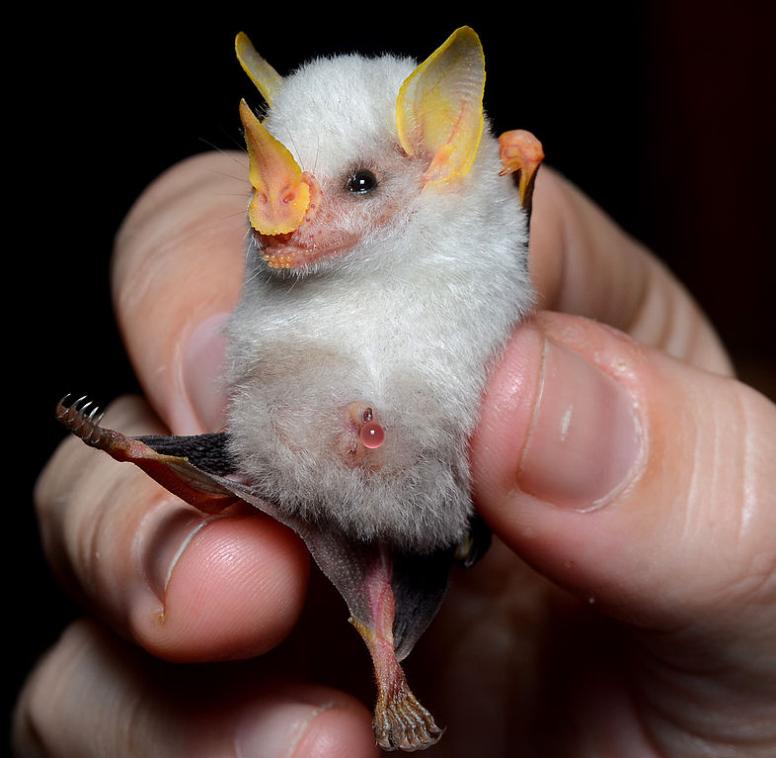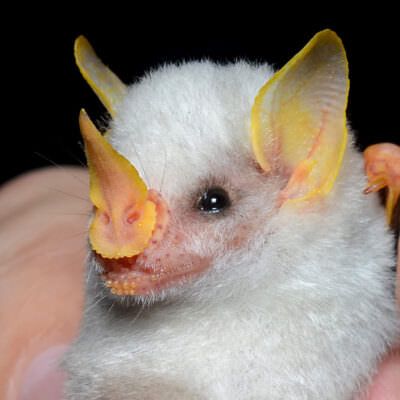White bats are incredibly rare and fascinating creatures. Out of over 1,300 known species of bats, only a handful have pure white or partly white fur. These unique bats inhabit remote corners across the Americas, Asia, and Australia. Some white bat species are extremely rare while others live in large colonies in tropical forests. Though elusive due to their nocturnal nature and remote forest habitats, learning about these mysterious white bats reveals a hidden side of nature. Here are 10 amazing white bats found around the world.
1. Canyon Bat
The Canyon Bat (Parastrellus hesperus) is a small white bat residing in the western United States and Mexico. They have bright white fur over most of their body contrasted by a dark brown face and wings. Canyon Bats emerge in early summer to breed and bear 1-2 pups. They are fairly solitary compared to other bats often roosting alone in rock crevices except when breeding. These bats may partially hibernate in winter if temperatures drop too low. Canyon Bats forage for insects at dusk and night. Their remote canyon habitats make them a rare sight.
2. Honduran White Bat
The Honduran White Bat (Ectophylla alba) is bright white with a yellow nose and ears, found in Central American rainforests They uniquely roost in “tents” made by modifying large rainforest leaves Females nibble veins on leaves, causing them to fold down into tents sheltering about a dozen bats. Their white fur camouflages them in the pale green tents. Honduran White Bats eat mostly figs and roost in small colonies. Deforestation threatens this bat, which is considered near threatened. Their yellow pigments are studied for insights on human vision diseases.
3. Northern Ghost Bat
The Northern Ghost Bat (Diclidurus albus) of Central and South America has a striking white and pinkish appearance They roost under palm leaves during the day and forage alone at night for insects These solitary bats fly high above the rainforest, making them extremely difficult to observe. Very little is known about their lifespan and habits. Their remote range likely protects them from major threats.
4. Lesser Ghost Bat
The Lesser Ghost Bat (Diclidurus scutatus) resembles the Northern Ghost Bat but lives in South America. They too take shelter under palm leaves, which they modify into tents. At night they emerge to snatched insects above the trees and waterways. Spotting these bats is a rare occurrence due to their elusive nocturnal habits. Their bright white fur provides camouflage under pale palm leaves during the day.
5. Greater Ghost Bat
The Greater Ghost Bat (Diclidurus ingens) of South America is another elusive white insect-eating species. It has a completely white body with a pink face and wings. This bat resides in tropical forests, roosting alone under palms and foraging at night well above the canopy. Little is known about this rarely seen species. Its ability to fly high helps it evade capture for study.
6. Isabelle’s Ghost Bat
Isabelle’s Ghost Bat (Diclidurus isabella) is a poorly understood white bat found across scattered sites in South America. It has white fur with some brown areas and distinct long front teeth. This solitary bat roams far above the rainforest at night, making it nearly impossible to observe and capture. Even basic details about its habits and diet remain a mystery. Isabelle’s Ghost Bat likely earned its name from its creamy white coloring.
7. Cuban Flower Bat
The Cuban Flower Bat (Phyllonycteris poeyi) is one of the few primarily nectar-feeding bats with white fur. It lives only in Cuba and is white to grayish with dark wings. This small bat feeds on pollen and nectar from night-blooming flowers. Unlike other white bats, it flies low and lives in caves in groups up to 100 strong. Still, the Cuban Flower Bat remains elusive to spot due to its nocturnal activity. It faces no major threats.
8. Ghost Bat
The Ghost Bat (Macroderma gigas) is a large bat found across northern Australia. It is pale gray to white with black wings and large ears. This formidable predator uses echolocation and keen vision to hunt birds, reptiles, and frogs. Ghost Bats even tackle prey as big as ducks! Their strong jaws and robust skull allow them to subdue large victims. Roosting in caves and mine shafts during the day, these bats emerge at night to hunt across open forests and fields.
9. Spotted Bat
The Spotted Bat (Euderma maculatum) is one of the rarest bats in North America. Its white underside and black spots make it unmistakable. However, its remote cliff habitats of western North America make it extremely difficult to observe and study. Little is known about its lifestyle besides feeding on moths. Advanced ears likely help it locate prey and elude predators. Spotted Bats roost alone in crevices and caves deep within canyons and cliffs, only leaving after dark to forage.
10. Albino Bats
While not a distinct species, albino bats occur across 61 species worldwide. Albinism causes a total lack of melanin pigments, turning bats completely white. Both parents must carry the albino gene for albino offspring to occur, making the condition very rare. Albino bats face greater threats from predators and may be shunned by normal bats. Their bright coloration makes them prized by collectors as well. With proper habitat, however, albino bats can live normal lifespans of 10-20 years.
The existence of bats with white fur remains an intriguing aspect of nature. These beautiful creatures have adapted to fill challenging niches across diverse environments worldwide. Their unique ecology remains shrouded in mystery in many cases. Protecting vulnerable tropical forests will hopefully allow endangered white bats to continue thriving far into the future. Their specialized adaptations provide insights on how a diversity of lifeforms can evolve to inhabit our planet. Even as scientific knowledge progresses, white bats will likely retain their aura of rarity and mystique for generations to come.

Ectophylla albaLast updated on September 14, 2023
With an average length of 3.7 – 4.7 cm, Honduran white bats are tiny for a bat. True to their name, they have a fluffy white coat. Their ears, face, nose and parts of their legs and wings are bright orange. Almost no hair grows on their black wings. Since their nose protrudes from their face in a triangular shape, scientists call members of their family “leaf-nosed bats.” There is a thin, black membrane covering their skull that might provide the bats with protection from ultraviolet radiation—a natural form of sunscreen!
Honduran white bats live only in the lowland rainforests of eastern Honduras, northern Nicaragua, eastern Costa Rica and western Panama. They live in rainforests that have heliconia plants. By cutting along the veins of heliconia leaves, these bats force the leaves to collapse into upside-down V-shaped “tents” that might shelter only one bat, or as many as twelve bats.
When they roost, they hang close together upside down in the center of the leaf. The tents help protect them during the daytime from rain, the hot sun and predators. In fact, the bats choose leaves that are six feet off the ground—high enough to be out of the reach of terrestrial predators. Also, the stems of heliconia plants are not very strong, so any predator brushing against the leaf causes the bats’ tent to shake. This alerts the bats to danger and they fly quickly away.
Why do Honduran white bats have bright white coats? Why are they not green like the leaves they hide inside? When the sun shines through the leaves of their tent, it makes the bats’ white coat appear green, making them hard to spot! However, their tent is not home sweet home for long. The bats rarely return to the same tent for more than a day.
During the day, Honduran white bats roost under their tents. At night, they emerge to search for food. However, these creatures are not looking to suck your blood—they only eat fruit or vegetation.
Since Honduran white bats live mainly under heliconia leaves, rainforest destruction is a serious threat. For this species to survive, rainforests in the Central American lowlands that have heliconia must remain standing. Natural predators may include opossums, snakes and other carnivorous animals.
- Jukofsky, Diane. Encyclopedia of Rainforests. Connecticut: Oryx Press, 2002.
- Casebeer, R.S., Linsky, R. B. and C. E. Nelson. 1963. The phyllostomid bats, Ectophylla alba and Vampyrum spectrum, in Costa Rica. Journal of Mammalogy. 44: 186 – 189.
- Timm, R. and J. Mortimer. 1976. Selection of roost sites by Honduran white bats, Ectophylla alba (Chiroptera: Phyllostomatidae). Ecology. 57: 385 – 389.
- University of Michigan Museum of Zoology
- The IUCN Red List of Threatened Species
- Small photo by Geoff Galice

Honduran White Bats Are the Cutest
FAQ
How rare is a white bat?
It has distinctive, entirely white fur, which is only found in six of the roughly 1,300 known species of bat.
Where do white bats live?
-
Geographic Range:They are found in Central America, ranging from Honduras through parts of eastern Nicaragua, Costa Rica, and western Panama.
-
Habitat:They inhabit lowland rainforests, preferring wet evergreen forests and secondary forests.
-
Roosting Behavior:They are known for building leaf “tents” by cutting along the veins of Heliconia leaves, creating upside-down V-shaped shelters.
-
Diet:They primarily eat figs from the Ficus colubrinae species.
-
Appearance:They are small, fluffy, and white, with bright orange-yellow faces, legs, and wings.
-
Conservation Status:The Honduran white bat is listed as “Near Threatened” by the IUCN Red List.
What do white bats represent?
White bats are rare and are often considered symbols of purity, protection, and spiritual guidance.
Where are white bats found?
White bats can be found around the world. From the depths of The Grand Canyon to the Amazon rainforest, these types of bats are found in The Americas, Asia, and Australia.
Are white bats considered rare?
White bats are often perceived as rare due to living in some of the most remote areas of the world. They also fly above the tree line at night, making them a very rare sight. The following species of white bats are representative of different and sometimes remote regions of the world.
Why are white bats hard to see?
White bats are hard to see because they fly above the tree line at night, which makes them a very rare sight. Additionally, they often live in some of the most remote areas of the world, contributing to their perceived rarity.
Do bats have white fur?
Unlike most bats, which have dark brown or black fur, these fascinating creatures possess soft, creamy white fur that blends seamlessly with the white shades of the flowers they frequent. This remarkable adaptation allows them to remain concealed and camouflaged amidst the lush vegetation of their habitat.
